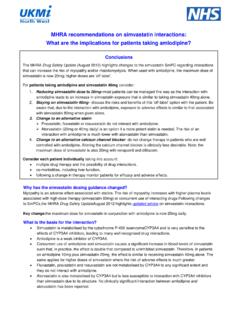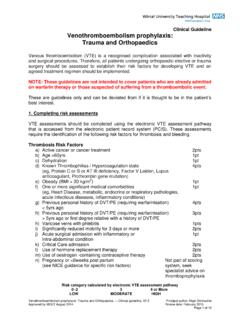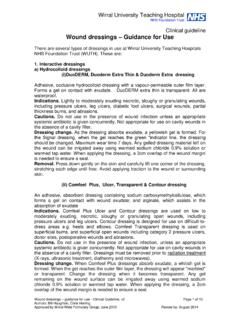Transcription of Heart failure: Managing newly diagnosed and …
1 Heart failure Managing newly diagnosed and decompensated patients in acute care clinical guidelines, v1 Principal author: Dr P Saravanan Approved by Medicines Clinical Guideline Team: July 2013 Review by: July 2016 Page 1 of 27 Heart failure : Managing newly diagnosed and decompensated patients admitted to hospital Clinical Guideline 1. Confirmation of Diagnosis Person with signs and symptoms suggesting Heart failure Detailed history and clinical examination Heart failure with preserved ejection fraction / diastolic dysfunction (EF >55%) -Update primary diagnosis on PCIS /Cerner and document in casenotes.
2 Consider aetiology for new diagnosis of Heart failure or underlying cause for exacerbation of chronic Heart failure and exclude treatable causes. Arrange other investigations: CXR ECG FBC U&Es and Creatinine LFTs TFTs RBG Cholesterol Confirmed diagnosis of Heart failure Diagnosis confirmed by previous echocardiogram Diagnosis confirmed by echocardiogram, if possible performed as an in-patient and adhering to Advancing Quality Heart failure (AQHF) indicators If current echocardiogram not clinically relevant, request repeat echo, if possible performed as an in-patient Suspected diagnosis of Heart failure Diagnosis has not been confirmed by echocardiogram Heart failure excluded so review diagnosis Heart failure due to significant left ventricular systolic dysfunction (EF < 40%)
3 Update primary diagnosis on PCIS / Cerner and document in casenotes Proceed to Management of Confirmed Heart failure Heart failure Managing newly diagnosed and decompensated patients in acute care clinical guidelines, v1 Principal author: Dr P Saravanan Approved by Medicines Clinical Guideline Team: July 2013 Review by: July 2016 Page 2 of 27 2. Inpatient management Heart failure with preserved ejection fraction Referral to Heart failure specialist team. Arrange admission to appropriate ward/unit Heart failure due to left ventricular systolic dysfunction (EF < 40%) Refer to Heart failure Specialist Nurse for lifestyle advice: Stop smoking (smoking history, if smoker in last 12 months verbal advice, NRT or referral to smoking cessation service and document all) Diet, exercise, symptom management, daily weights, medication, alcohol reduction / abstinence, annual flu vaccine x 1 Give Heart failure information leaflet to patient or family /carer Fluid balance.
4 Restriction 1-2 litres in 24 hours restricted diet loop diuretics furosemide 40mg od or increase and titrate according to symptoms. If required slow intravenous injection initially 50mg, increased by 20mg increments (ie, to 70mg, 90mg, etc) not less than every 2 hours (doses depend upon clinical state and previous oral doses) In severe cases following review from Heart failure team, a thiazide ( bendroflumethiazide) may be added under close supervision Drug management: ACE inhibitor (ACEI) and titrate upwards. or If ACEI not tolerated, consider angiotensin-receptor blocker in NYHA Class I-IV.
5 Beta blockers, when Heart failure stable, and titrate upwards in NYHA Class I IV. NB: if ACE I, ARB or beta blocker is contra indicated, document reason in casenotes. spironolactone 25mg od, up to 50mg od in NYHA Class III-IV. Close monitoring of U&Es & creatinine required. NB eplerenone can be used as second line only if patient has painful gynaecomastia (unlicensed) ivabradine in line with NICE TA 237. low dose digoxin if in sinus rhythm. remains symptomatic and intolerant to spironolactone, consider addition of candesartan to ACE I under specialist supervision.
6 Hydralazine and nitrate combination in African / Caribbean End of life care: Refer to guidelines for referral to specialist palliative care in end stage Heart failure Complete DS 1500 If appropriate, initiate The Liverpool Care of the Dying Pathway (LCP) Ensure ICD is deactivated Ward monitoring of Heart failure patients : Daily weights Strict fluid balance Sitting & standing BP Pulse Daily U&Es Monitor for improvement or deterioration in Heart failure symptoms. a) if still symptomatic on optimal tolerated drug therapy refer to Cardiologist for consideration of biventricular pacemaker/ cardiac resynchronisation therapy (CRTP/CRTD) provided: <35% > 120 ms a) consider referral for assist devices and transplant Discharge planning: Ensure Heart failure discharge letter is completed in a timely manner detailing: correct primary diagnosis, echo result, medication commenced and/or discontinued, discharge blood results, discharge weight, required monitoring, and ward follow-up arrangements from acute Trust.
7 Refer to Heart failure specialist nurse service for follow-up For more information see Heart failure Website - Heart failure - NHS Choices Heart failure Managing newly diagnosed and decompensated patients in acute care clinical guidelines, v1 Principal author: Dr P Saravanan Approved by Medicines Clinical Guideline Team: July 2013 Review by: July 2016 Page 3 of 27 Signs and symptoms suggesting Heart failure (back to top) Signs: Tachycardia, Gallop rhythm, crackles, raised jugular venous pressure The main clinical signs of Heart failure are due to: Cardiomegaly ie, displaced apex beat, third Heart sound Congestion ie, oedema, jugular venous distension, pulmonary crackles Activation of the sympathetic nervous system tachycardia Symptoms: Dyspnoea, paroxysmal nocturnal dyspnoea (PND), fatigue, oedema The classic symptoms of Heart failure are dyspnoea and fatigue.
8 However, orthopnoea is more specific than exertional dyspnoea when diagnosing Heart failure , although its low sensitivity means it has little predictive value. PND has a greater sensitivity and predictive value. Aetiology (back to top) Ischaemic Heart disease, dilated cardiomyopathy, primary valvular disease, hypertension, cardiac arrhythmias, viral infections, toxic substances (alcohol/certain medicines), anaemia, hyperthyroidism, pregnancy, congenital Heart disease Occasionally no cause of Heart failure can be found (ie, idiopathic) Treatable causes and aggravating factors (back to top)
9 Anaemia Hyperthyroidism Non-compliance with medication Other medicines non-steroidal anti-inflammatory drugs, corticosteroids, diltiazem, verapamil, alcohol Fast AF Infection Uncontrolled blood pressure Impaired renal function Heart failure Managing newly diagnosed and decompensated patients in acute care clinical guidelines, v1 Principal author: Dr P Saravanan Approved by Medicines Clinical Guideline Team: July 2013 Review by: July 2016 Page 4 of 27 Heart failure with preserved LV systolic function diagnosis and management (back to top) patients with: Clinical symptoms and signs of Heart failure Supporting laboratory tests (eg, chest X-ray showing pulmonary oedema) A typical clinical response to treatment with diuretics and Echocardiography showing ejection fraction 50% can be classed as having HF with preserved LV systolic function.
10 It would be useful to ensure that patients have at least one of the following in echocardiography, even though presence of these criteria is not imperative to make the diagnosis: 1) Left atrium dilatation 2) Evidence of left ventricle hypertrophy 3) E/A ratio* more than 1 (trans-mitral doppler) 4) IVRT **>110msec or <60 Msec (restrictive filling) *E=early passive filling of the left ventricle, A=late left ventricle filling due to atrial contraction. In normal compliant ventricles, early filling should contribute to nearly 80% of the filling, which reverses when the ventricles do not relax well (diastolic dysfunction).














